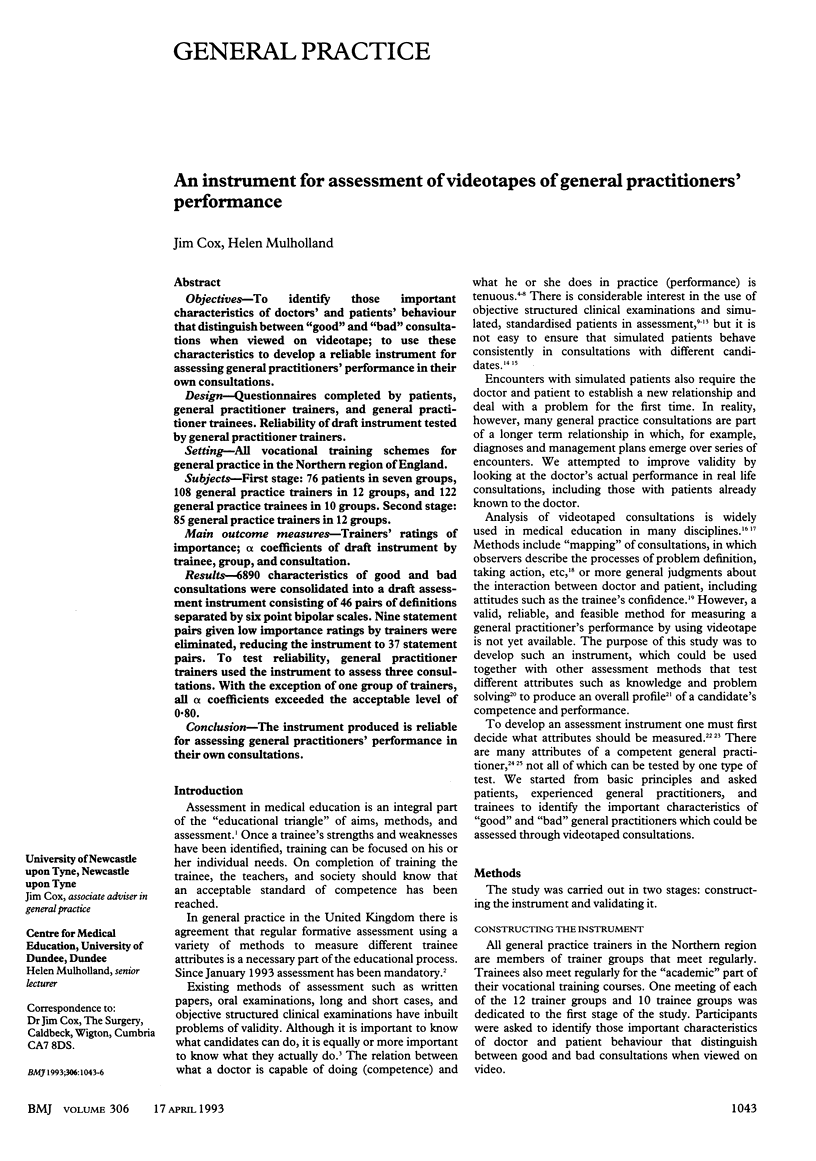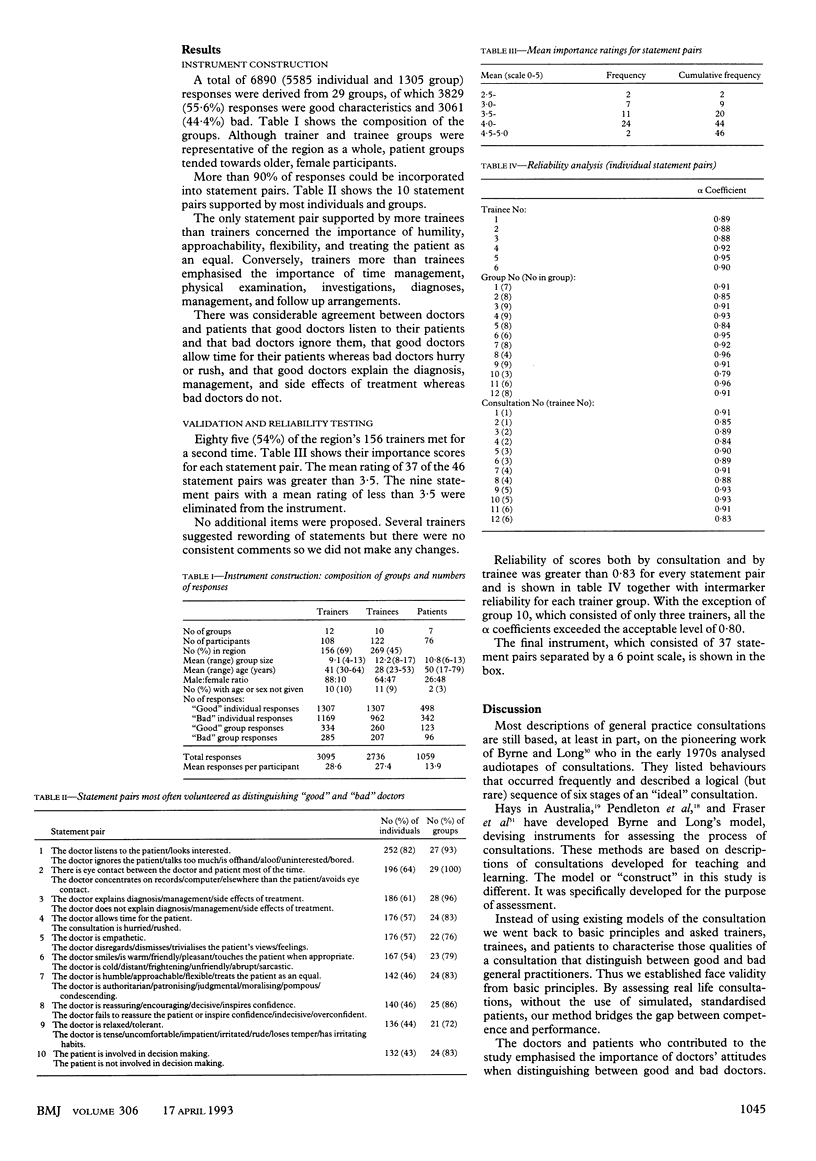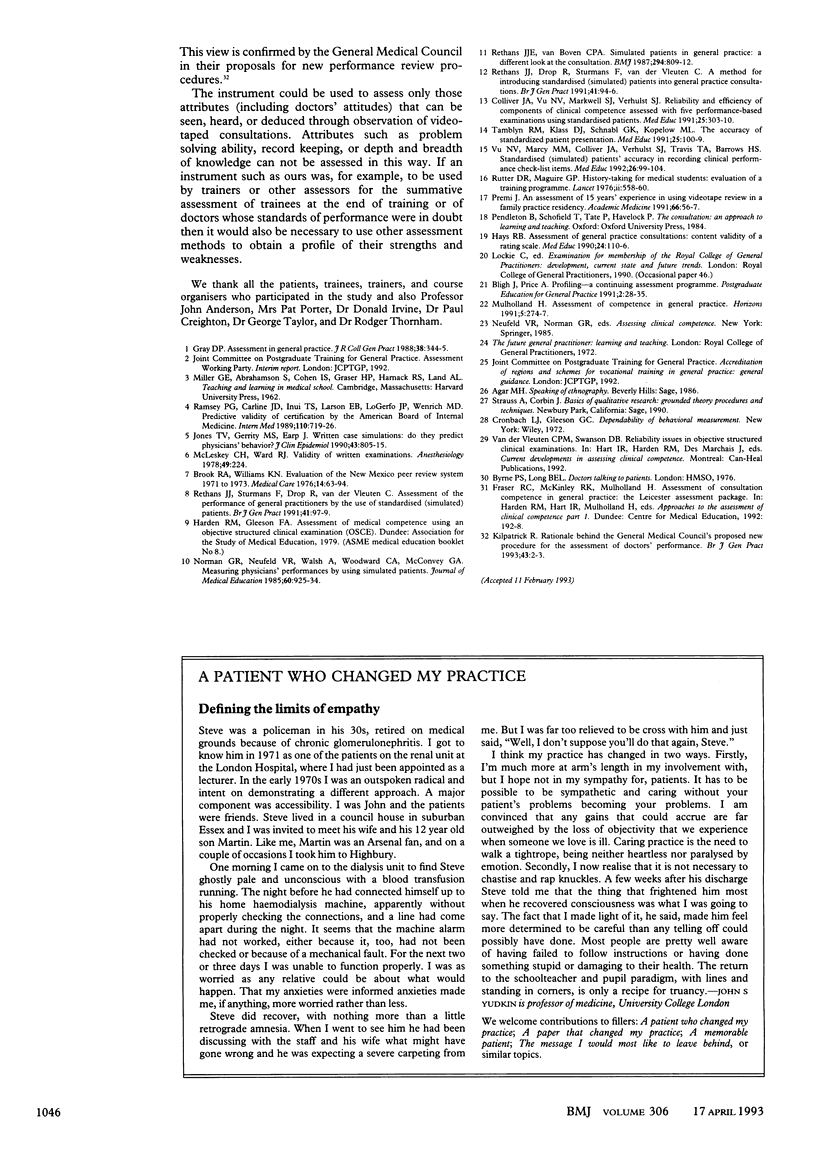Abstract
OBJECTIVES--To identify those important characteristics of doctors' and patients' behaviour that distinguish between "good" and "bad" consultations when viewed on videotape; to use these characteristics to develop a reliable instrument for assessing general practitioners' performance in their own consultations. DESIGN--Questionnaires completed by patients, general practitioner trainers, and general practitioner trainees. Reliability of draft instrument tested by general practitioner trainers. SETTING--All vocational training schemes for general practice in the Northern region of England. SUBJECTS--First stage: 76 patients in seven groups, 108 general practice trainers in 12 groups, and 122 general practice trainees in 10 groups. Second stage: 85 general practice trainers in 12 groups. MAIN OUTCOME MEASURES--Trainers' ratings of importance; alpha coefficients of draft instrument by trainee, group, and consultation. RESULTS--6890 characteristics of good and bad consultations were consolidated into a draft assessment instrument consisting of 46 pairs of definitions separated by six point bipolar scales. Nine statement pairs given low importance ratings by trainers were eliminated, reducing the instrument to 37 statement pairs. To test reliability, general practitioner trainers used the instrument to assess three consultations. With the exception of one group of trainers, all alpha coefficients exceeded the acceptable level of 0.80. CONCLUSION--The instrument produced is reliable for assessing general practitioners' performance in their own consultations.
Full text
PDF



Selected References
These references are in PubMed. This may not be the complete list of references from this article.
- Colliver J. A., Vu N. V., Markwell S. J., Verhulst S. J. Reliability and efficiency of components of clinical competence assessed with five performance-based examinations using standardized patients. Med Educ. 1991 Jul;25(4):303–310. doi: 10.1111/j.1365-2923.1991.tb00071.x. [DOI] [PubMed] [Google Scholar]
- Gray D. P. Assessment in general practice. J R Coll Gen Pract. 1988 Aug;38(313):344–345. [PMC free article] [PubMed] [Google Scholar]
- Hays R. B. Assessment of general practice consultations: content validity of a rating scale. Med Educ. 1990 Mar;24(2):110–116. doi: 10.1111/j.1365-2923.1990.tb02508.x. [DOI] [PubMed] [Google Scholar]
- Jones T. V., Gerrity M. S., Earp J. Written case simulations: do they predict physicians' behavior? J Clin Epidemiol. 1990;43(8):805–815. doi: 10.1016/0895-4356(90)90241-g. [DOI] [PubMed] [Google Scholar]
- McLeskey C. H., Ward R. J. Validity of written examinations. Anesthesiology. 1978 Sep;49(3):224–224. doi: 10.1097/00000542-197809000-00021. [DOI] [PubMed] [Google Scholar]
- Norman G. R., Neufeld V. R., Walsh A., Woodward C. A., McConvey G. A. Measuring physicians' performances by using simulated patients. J Med Educ. 1985 Dec;60(12):925–934. doi: 10.1097/00001888-198512000-00004. [DOI] [PubMed] [Google Scholar]
- Premi J. An assessment of 15 years' experience in using videotape review in a family practice residency. Acad Med. 1991 Jan;66(1):56–57. doi: 10.1097/00001888-199101000-00018. [DOI] [PubMed] [Google Scholar]
- Ramsey P. G., Carline J. D., Inui T. S., Larson E. B., LoGerfo J. P., Wenrich M. D. Predictive validity of certification by the American Board of Internal Medicine. Ann Intern Med. 1989 May 1;110(9):719–726. doi: 10.7326/0003-4819-110-9-719. [DOI] [PubMed] [Google Scholar]
- Rethans J. J., Drop R., Sturmans F., van der Vleuten C. A method for introducing standardized (simulated) patients into general practice consultations. Br J Gen Pract. 1991 Mar;41(344):94–96. [PMC free article] [PubMed] [Google Scholar]
- Rethans J. J., Sturmans F., Drop R., van der Vleuten C. Assessment of the performance of general practitioners by the use of standardized (simulated) patients. Br J Gen Pract. 1991 Mar;41(344):97–99. [PMC free article] [PubMed] [Google Scholar]
- Rethans J. J., van Boven C. P. Simulated patients in general practice: a different look at the consultation. Br Med J (Clin Res Ed) 1987 Mar 28;294(6575):809–812. doi: 10.1136/bmj.294.6575.809. [DOI] [PMC free article] [PubMed] [Google Scholar]
- Rutter D. R., Maguire G. P. History-taking for medical students. II-Evaluation of a training programme. Lancet. 1976 Sep 11;2(7985):558–560. doi: 10.1016/s0140-6736(76)91805-5. [DOI] [PubMed] [Google Scholar]
- Tamblyn R. M., Klass D. J., Schnabl G. K., Kopelow M. L. The accuracy of standardized patient presentation. Med Educ. 1991 Mar;25(2):100–109. doi: 10.1111/j.1365-2923.1991.tb00035.x. [DOI] [PubMed] [Google Scholar]
- Vu N. V., Marcy M. M., Colliver J. A., Verhulst S. J., Travis T. A., Barrows H. S. Standardized (simulated) patients' accuracy in recording clinical performance check-list items. Med Educ. 1992 Mar;26(2):99–104. doi: 10.1111/j.1365-2923.1992.tb00133.x. [DOI] [PubMed] [Google Scholar]


